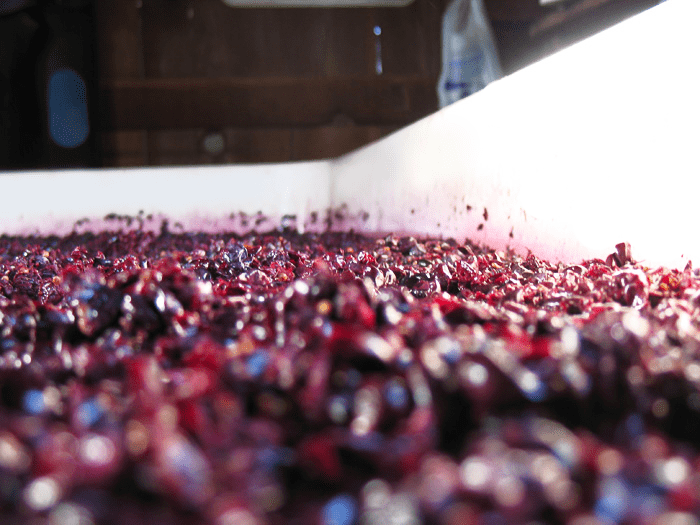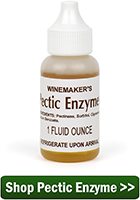 This is Greg again with another question. I have been making wine with your concentrated homemade wine kits for several years and have had a lot of fun for sure. I would like to make apple wine… saw the apple recipe you have on your website. It looks a lot like making wine from concentrate. The only thing I do not understand is the pectic enzyme. What is the purpose of adding pectic enzyme to a wine?
This is Greg again with another question. I have been making wine with your concentrated homemade wine kits for several years and have had a lot of fun for sure. I would like to make apple wine… saw the apple recipe you have on your website. It looks a lot like making wine from concentrate. The only thing I do not understand is the pectic enzyme. What is the purpose of adding pectic enzyme to a wine?
Greg
—–
Dear Greg,
Pectic enzyme is called for in almost all wine recipes that use fresh fruit. The recipes you see in books like The First Steps In Wine Making and the wine recipes on our website will all call for pectic enzymes. However, you do not need to add it to wines made from concentrated homemade wine kits, like the ones you have been making wine with. This is because the necessary pectic enzyme has already been added to the concentrate by the wine kit producer.
The purpose of using pectic enzyme in wine making is twofold:
- First and foremost, pectic enzyme helps to break down the fruit’s fiber or pulp. This allows more flavor and color to be extracted from whatever fruit is being used during the fermentation.
 Secondly, it helps to make sure the wine has a clearer, more translucent, appearance after the fermentation has completed and the wine has had ample time to clear up.
Secondly, it helps to make sure the wine has a clearer, more translucent, appearance after the fermentation has completed and the wine has had ample time to clear up.
Pectic enzyme accomplishes both of these tasks by breaking down the pectin cells in the fruit. Pectin is the gelatinous material that holds together the strands of fiber found within fruits such as strawberry or grape. It is also the “stuff” that makes apple sauce thick and cloudy.
By breaking down these pectin cells, the fruit’s pulp becomes less thick. This allows more of the fruit’s character to be released during fermentation or even when running the pulp through the grape presses. Because pectin is somewhat opaque, if it isn’t sufficiently broken down during the fermentation, the resulting wine will have a pectin haze. For the most part, this type of defect is not correctable once the fermentation is complete.
When making wine from concentrated homemade wine kits, the flavor and color extraction has already been taken care of for you. No pulp is involved and Pectic enzyme is not necessary. It’s one more variable that these kits take out of the equation so that you can be a successful home wine maker.
 So as you can start to see there is a reason for adding pectic enzyme to a wine. Pectic enzyme has a purpose. It helps to extract more color and flavor from the fruit, and it helps to insure that the resulting wine is clear.
So as you can start to see there is a reason for adding pectic enzyme to a wine. Pectic enzyme has a purpose. It helps to extract more color and flavor from the fruit, and it helps to insure that the resulting wine is clear.
Happy Wine Making,
Ed Kraus
—–
Ed Kraus is a 3rd generation home brewer/winemaker and has been an owner of E. C. Kraus since 1999. He has been helping individuals make better wine and beer for over 25 years.

Yes, you can add pectic enzyme now and try to start a second fermentation. The problem is, it’s not guaranteed that a second fermentation will start. The presence of alcohol, lack of nutrients, among other things, makes this endeavor very unpredictable and very risky. If you fail, the wine can end up tasting disgustingly sweet. A better option is to add a double-dose of pectic enzyme now and simply let the wine age with it.
I am 67 years Young of India and never tasted hard drinks but as hobby I am making variety of fruit wines since 1970 to offer my friends and now I am doing a bit of consultancy for wine making.
what happens if you dont use the pectic enzyms in your wine???
Most of the time, if you don’t use Pectic Enzyme your wine will turn out just fine. But what can happen is your wine can develop a pectin haze. This is a permenant haze in the wine that can not be removed with clarifiers and such.
I have two batches of Muscadine wine Black and Golden.Primary fermentation is still gooing strong after 7 days and I am about to transfer to secondary fermentation…can I add the pectin or is it too late?
You do not want to add pectin. That is the opposite of the pectic enzyme we are talking about above. To answer your question, it is never too late to add pectic enzyme to a wine. Go ahead and add it. There is no downside in doing so, only potential benefit to the wine.
Another benefit to leaving the pectic enzyme out is that you can use bentonite which helps clarify the wine. I know it sounds weird to be thinking about clarifying on day-one but it helps. If you use both, the bentonite cancels out the effect of the pectic enzyme.
Most importantly, if you are using a kit, stick to the recipe unless you are willing to risk the consequences (because you’ve tried the recipe a few times and want to experiment to see what something else does). Usually, it turns out worse.
Sorry Mark J, but this makes no sense, “you can’t use bentonite if you use Pectic Enzyme”? Empirically, I can attest that this is NOT true. Pectic Enzyme and bentonite act in two very different manners… PE breaks down pectin, and bentonite floculates proteins from in the wine (but not pectins which are VERY long chain carbs) I ALWAYS use pectic enzyme (truly no reason not to), and I ALWAYS use bentonite (after fermentation, not before). The bentonite gets it close to being crystal clear, and to push it over the finish line, Keisesol and chitosan for the win.
What is the difference between liquid an powdered pectic Enzyme?
I purchased a powdered enzyme when making cranberry wine last year and I now have a grape recipe that calls for liquid enzyme.
Ron, there is really no difference at all in how they function. Their strength can very regardless of what form they come in, so it is best that you follow any directions that come on the package.
Again, thank you for your blog. Is there a benefit of using bentonite over pectic enzyme as Mark J said? What is the shelf life of pectic enzyme? Also if yeast energizer and or nutrient is past the used by date, can you use it if you cannot detect a rancid odor? The cost is minimal but sometimes you may be in a pinch and need to take a chance. Thanking you again. Mel
Mel, if you are making wine from fresh fruits, you need to use pectic enzyme to bring out more fruit flavor and help insure that your wine does not end up with a pectin haze. While bentonite should be used after the fermentation to clear out proteins, it will not prevent a pectin haze from occurring. Pectic enzyme loses about 10% of it’s activity level every month at normal room temperature. Using out-dated nutrients will not hurt the wine, just realize that it my have lost most of its effectiveness.
i;m making juice from chokecherries for wine by pouring boiling water on them and will break them up after the skins have softened. can i add pectic enzyme when it’s hot or does heat affect the enzyme?
Patrick, unfortunately pectic enzyme, like any enzyme is reactive to heat. It actually most active at around 125°F. As you go above or below that temperature it becomes marginally active. And, like most organic elements they will start to die or become denatured at about 180°F. So I guess you could put the pectic enzyme in as you are heating up the fruit and treat it similar to a brew mash. Hold the heat at around 120°F. to 130°F. for a will then heat it on up for extraction.
I forgot to add the pectic enzyme 12 hours prior to adding my yeast starter. Nutrient and oakmor. I added it about 1 hour before. How might this effect my fermentation and over all product?
Cathy, as long as you added the pectic enzyme before fermentation began, it will not affect your fermentation process. Even if you forget to add it and added it later in the process all you need to do is add a double dose.
I have two books that both refer to Peptic Acid is this the same as Peptic Enyme
I have a large raspberry patch and have been making raspberry wine for a couple of years I think it’s pretty good but I’m wondering if it could be better if I test the acid level and adjust if necessary in your opinion is this necessary
Roy, yes we do feel that starting your juice out with the proper level of acidity is essential. Acidity is a major component to producing a stable wine with an agreeable balance and overall character. I would recommend taking a look at the article posted below for more information on this subject.
Acidity
http://www.eckraus.com/wine-making-acidity
Can pectin enzyme be added and a second fermentation begun to correct hazy wine? I have some peach/apricot that is hazy. My recipe did not call for pectin enzyme but did call for grape tannin which ibjrs supposed to help with clearing but that does not seem to have happened.
If my wine already aged about 9 months and I’m about to cold stabilize it, by putting the carboy in the fridge for three weeks, should i add pectin enzyme before I do that If I haven’t already during the wine making process. I just want it to be as stable as possible. I haven’t used any bentonite or clarification methods on it, its white wine. any recommendations on how to stabilize it for heat?
Erin, if you have not added pectic enzyme I would definitely add it now. For information on making your wine heat stable, please take a look at the article posted below.
Maintaining Temperature Stability In Your Wine
https://eckraus.com/wine-making-stabilization/
I want to backsweeten my white grape peach wine with white grape peach concentrate. I used pectic enzyme prior to primary fermentation. Should I add additional pectic enzyme at this point for the concentrate addition?